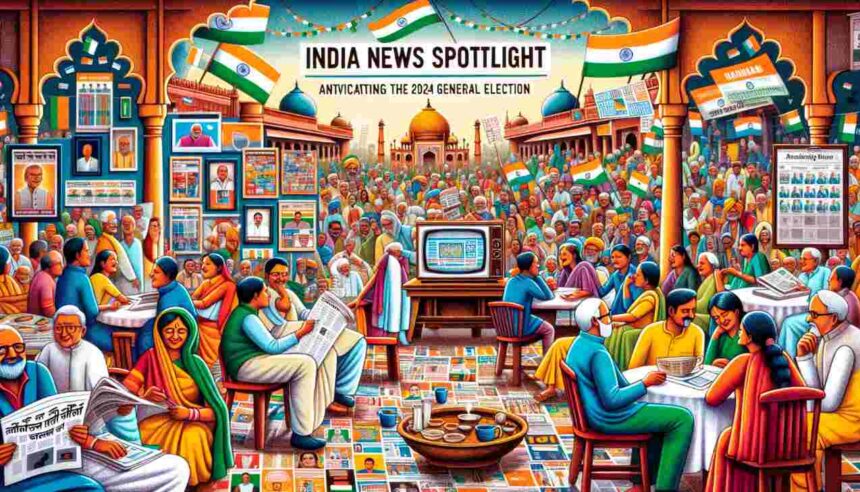India stands on the brink of the 2024 Lok Sabha elections, a monumental event in India news, showcasing the vibrancy of its democratic ethos. With a multi-party system at its core, the political landscape is dominated by the Bharatiya Janata Party (BJP), led by Prime Minister Narendra Modi since 2014, and the Indian National Congress (INC), highlighting the dynamic interplay of power at the national level. The upcoming elections are poised to mark a significant chapter in India’s democracy, as the tenure of the 17th Lok Sabha ends on June 16, 2024, setting the stage for over 970 million voters to elect 543 members to the lower house of Parliament for a five-year term.
Globally, the 2024 Lok Sabha elections are anticipated to be one of the most consequential events, not just as a pivotal moment in India but as a signal of democratic practice to the world, especially amid a year when over 50 countries will head to the polls. With the BJP and the INC fronting the electoral battle, figures like Narendra Modi and Rahul Gandhi become central to both the discourse and the direction of Indian politics. This election is not just about governance but stands as a testament to India’s influence on the global stage, promising to engage and shape the future of nearly 1.4 billion people.
Electoral Process and Schedule
The Electoral Process and Schedule for the 2024 Lok Sabha elections in India are meticulously planned to accommodate the vast electorate and ensure a smooth electoral process. Here’s a breakdown:
- Election Duration and Phases:
- The elections will span over 44 days, from April 19 to June 1, divided into seven phases to manage the logistical challenges of such a large-scale exercise.
- Phase details are as follows: Phase 1 on April 19, Phase 2 on April 26, Phase 3 on May 7, Phase 4 on May 13, Phase 5 on May 20, Phase 6 on May 25, and Phase 7 on June 1.
- Voting and Counting:
- Approximately 970 million eligible voters will participate, casting their votes at over a million polling stations across India’s 28 states and 8 territories.
- Electronic Voting Machines (EVMs) will be used for voting, with results scheduled to be announced on June.
- Simultaneous Elections:
- Alongside the Lok Sabha elections, Legislative Assembly elections in Andhra Pradesh, Arunachal Pradesh, Odisha, and Sikkim will also be conducted, ensuring efficient use of resources and personnel.
This comprehensive schedule and process aim to facilitate the participation of a vast electorate, ensuring the democratic process is upheld with integrity and efficiency.
Major Political Parties and Alliances
In the run-up to the 2024 Lok Sabha elections, the political landscape of India is marked by the dominance of major parties and the formation of strategic alliances. Here’s a closer look at the key players:
- Bharatiya Janata Party (BJP):
- Leadership: Led by Prime Minister Narendra Modi, who is seeking a third successive term.
- Past Performance: Won single-party majorities in the last two Lok Sabha elections.
- Current Strengths: Aims for a 370-seat goal in UP, bolstered by Modi’s candidature in Varanasi and the new Ram temple in Ayodhya.
- Challenges: Faces limitations due to weak showings in many state elections, currently holding 12 chief minister positions.
- Indian National Developmental Inclusive Alliance (I.N.D.I.A.):
- Composition: A big-tent, mostly centre-left to left-wing bloc of 40 political parties, including the Indian National Congress (INC) and the Aam Aadmi Party (AAP).
- Objectives: Formed to protect democratic values, promote welfare and progress, and counter ideologies threatening the idea of India.
- Strengths: Support from seven State Chief Ministers and 142 members in the Lok Sabha.
- Key Regional Parties:
- Samajwadi Party: Strong base in OBC and Muslim communities, leadership centered around the Yadav family.
- Bahujan Samaj Party: Strong support among Dalit voters, heavily reliant on Mayawati’s leadership.
This dynamic interplay between national powerhouses and strategic alliances sets the stage for a fiercely contested election, underscoring the vibrant multiparty democracy of India.
Key Election Issues
The 2024 Lok Sabha elections are shaping up to be a battleground for several critical issues that are central to India’s future as a secular democracy. Here are the key election issues outlined:
- Secularism and Democracy:
- D Raja of the Communist Party of India emphasizes the importance of the elections for India’s secular democracy, highlighting the need to defeat the BJP to save the Constitution and democracy.
- The BJP’s communal politics, attempts to divide people on religious lines, and efforts to impose a theocratic state are significant concerns.
- Economic Challenges and Unemployment:
- Rising unemployment is a pressing issue, with the youth unemployment rate at 23.2%.
- Despite being one of the fastest-growing economies, India struggles with job creation for its young population. The economy’s state, coupled with high income and wealth inequality, underscores the urgency for effective economic policies.
- Governance and Political Climate:
- The Modi government’s tenure has seen attacks on religious minorities, particularly Muslims, a shrinking space for dissent and free media, and controversies over the Electoral Bond system.
- Opposition parties argue that institutional governance and the rule of law have eroded, with instances of favoritism towards the ruling establishment’s allies.
These issues, alongside the dynamics of Hindu nationalism, the impact of Mandir Politics, and the debate over the Citizenship Amendment Act (CAA), will likely be decisive in determining the outcome of the elections.
Prominent Campaigns and Promises
Prominent campaigns and promises in the lead-up to the 2024 Lok Sabha elections have seen political parties making strategic moves and declarations:
- Bharatiya Janata Party (BJP):
- Campaign Focus: Highlighting past achievements and future promises with a narrative that the party has rescued the country from past follies, asserting that “the best is yet to come”.
- Promises: The ‘Viksit Bharat’ agenda, aiming to address issues pertinent to the poor, youth, women, and farmers. The BJP also seeks a 400+ majority in the Lok Sabha elections, showcasing its confidence.
- Controversies: Critics argue that slogans like ‘Modi ki Guarantee’ are mere election-time rhetoric, questioning the fulfillment of such promises. The use of the Ram temple consecration for political gain has also been a point of contention.
- Indian National Congress and Allies (I.N.D.I.A. Alliance):
- Manifesto Release: Scheduled for April 5 at the All India Congress Committee office in New Delhi, signaling the party’s readiness to present its vision.
- Strategic Moves: The alliance has formed a 14-member coordination committee to decide on important issues and announced that seat-sharing arrangements will be initiated immediately.
- Campaign Themes: The opposition’s campaign is centered around themes of authoritarianism and corruption, aiming to contrast its governance model with that of the BJP.
These campaigns reflect the strategic positioning and promises made by the major political players, setting the stage for a highly contested election.
The Future of Indian Politics
- Policy Continuity and Market Confidence:
- A decisive mandate for the current government would bolster investor confidence, potentially leading to a positive impact on the stock market.
- Historical data shows the Indian stock market has offered positive returns post-elections, with notable increases in 2004 (16.1%), 2009 (38.7%), and 2014 (14.7%) over the one-year period following the election results.
- Digitalization and Economic Policies:
- Further progress towards digitalization and a continued policy push toward manufacturing/exports are expected if the BJP forms the government with a majority.
- The Modi government’s recent steps on foreign investment and trade, along with significant steps in security relations, underscore a focus on strengthening India’s economic and strategic posture.
- Political Representation and Alliances:
- The framework for political representation in India could see changes due to uneven population growth, impacting future elections and political strategies.
- The BJP’s current lead in opinion polls and recent state victories positions it favorably for the 2024 elections. However, alliances are still navigating seat-sharing agreements, with different strategies in key states like West Bengal, Delhi, Punjab, and Uttar Pradesh, illustrating the complex dynamics of coalition politics.
Conclusion
As the curtain draws near on the anticipatory stage of the 2024 Lok Sabha elections, the political arena of India is ripe with the potential for pivotal shifts and continuities in governance. Reflecting on the discussions, it’s clear that the electoral process, along with the diversity and dynamics exhibited by major political parties and alliances, paints a complex picture of India’s democratic vibrancy. The engagement in key election issues, alongside the strategic campaigns and promises made by the contending parties, underscores the critical juncture at which India stands today—not only in terms of its domestic agenda but also in its global standing and influence.
Navigating through the multifaceted landscape of electoral politics, the upcoming elections emanate significant implications for the future of democracy, secularism, economic policies, and digital advancements in India. These implications reverberate beyond national borders, underscoring India’s role on the world stage. As the electorate prepares to make its choice, the echoes of this political process will undoubtedly shape the contours of India’s governance and democratic ethos. The journey towards the Lok Sabha 2024 polls, thus, is not just a testament to the power of the vote but a beacon of India’s enduring commitment to its democratic principles and aspirations for a progressive future.
FAQs
How long has the BJP been in power in India?
The Bharatiya Janata Party (BJP) has been the ruling political party in India since the year 2014, with Narendra Modi serving as the Prime Minister. The BJP is associated with right-wing politics and maintains close connections with the Rashtriya Swayamsevak Sangh (RSS), which is a volunteer paramilitary group.
What is the total number of Lok Sabha seats in India?
India is divided into 543 Parliamentary Constituencies for the election of the Lok Sabha, the lower house of Parliament. Each constituency elects one member to the Lok Sabha.
Which session of the Lok Sabha is currently in progress in India?
The current session of the Lok Sabha in India is the 17th Lok Sabha, which was elected in May 2019.
Can you provide a brief history of the BJP?
The Bharatiya Janata Party (BJP) has its origins in the Bharatiya Jana Sangh (BJS), which was established by Syama Prasad Mookerjee in 1951. The BJS was formed at a time when the Indian National Congress was the dominant political party in India.








